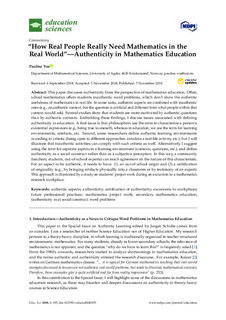| dc.description.abstract | This paper discusses authenticity from the perspective of mathematics education. Often, school mathematics offers students inauthentic word problems, which don’t show the authentic usefulness of mathematics in real life. In some tasks, authentic aspects are combined with inauthentic ones (e.g., an authentic context, but the question is artificial and different from what people within that context would ask). Several studies show that students are more motivated by authentic questions than by authentic contexts. Embedding these findings, I discuss issues associated with defining authenticity in education. A first issue is that philosophers use the term to characterize a person’s existential expressions (e.g., being true to oneself), whereas in education, we use the term for learning environments, artefacts, etc. Second, some researchers define authentic learning environments according to criteria (being open to different approaches, simulate a real-life activity, etc.), but I will illustrate that inauthentic activities can comply with such criteria as well. Alternatively, I suggest using the term for separate aspects in a learning environment (contexts, questions, etc.), and define authenticity as a social construct rather than as a subjective perception. In this way, a community (teachers, students, out-of-school experts) can reach agreement on the nature of this characteristic. For an aspect to be authentic, it needs to have: (1) an out-of-school origin and (2) a certification of originality (e.g., by bringing artifacts physically into a classroom or by testimony of an expert). This approach is illustrated by a study on students’ project work during an excursion to a mathematics research workplace. | nb_NO |

